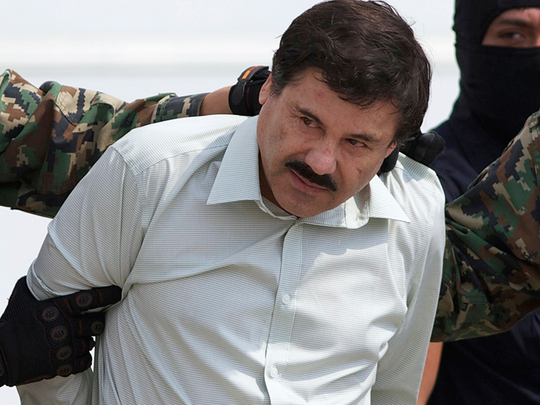
The man and the myth: Known as El Chapo for his short, stocky frame, Joaqun Guzman is 56, but there are discrepancies over his exact date of birth.
He is a quasi-mythical figure in Mexico, the subject of countless ballads, who has outlived enemies and accomplices alike, defying the implicit bargain of a life in the drug trade: that careers are glittering, but brief and always terminate in prison or the grave.
The Sinaloa cartel: Guzman’s Sinaloa cartel can buy a kilogram of cocaine in the highlands of Colombia or Peru for around $2,000 (Dh7,346), then watch it accrue value as it makes its way to market.
In Mexico, that kilogram fetches more than $10,000. Jump the border to the US, and it could sell wholesale for $30,000. Break it down into grams to distribute retail, and that same kilogram sells for upward of $100,000 — more than its weight in gold. And that’s just cocaine.
Diversified and violent
Alone among the Mexican cartels, Sinaloa is both diversified and vertically integrated, producing and exporting marijuana, heroin and methamphetamine as well. Mexican cartels reap $18 billion to $39 billion from drug sales in the United States each year. By most estimates, though, Sinaloa has achieved a market share of at least 40 per cent and perhaps as much as 60 per cent
A global organisation
Sinaloa didn’t merely survive the recession — it has thrived in recent years. And after prevailing in some recent mass-casualty clashes, it now controls more territory along the border than ever. The state of Sinaloa, from which the cartel derives its name, lies wedged between the Sierra Madre Occidental and Mexico’s west coast. Sun-blasted and remote, Sinaloa is the Sicily of Mexico, both cradle and refuge of violent men, and the ancestral land of many of the country’s most notorious traffickers.
A single route
At first, Chapo’s organisation controlled a single smuggling route, through western Mexico into Arizona. But by 1990, it was moving three tons of cocaine each month over the border, and from there, to Los Angeles. Working with Colombian suppliers, cartel operatives moved cocaine into Mexico in small private aircraft and in baggage smuggled on commercial flights and eventually on their own 747s, which they could load with as much as 13 tons of cocaine. They used container ships and fishing vessels and go-fast boats and submarines — crude semi-submersibles at first, then fully submersible subs, conceived by engineers and constructed under the canopy of the Amazon, then floated downriver in pieces and assembled at the coastline.
Grown in America
Improvisation is a trafficker’s greatest asset, and in recent years, Sinaloa has devised an even more efficient solution to the perennial challenge of getting marijuana across the border. Grow it there. Several years ago, a hunter was trekking through the remote North Woods of Wisconsin when he stumbled upon a vast irrigated grow site, tended by a dozen Mexican farmers armed with AK-47’s, a Sinaloa pot farm.
Quality and quantity
Heroin is easier to smuggle, but difficult to produce, and as detailed in court documents, Chapo is particularly proud of his organisation’s work with the drug. He personally negotiates shipments to the United States and stands by its quality, which is normally 94 per cent pure.
Tunnel vision
Chapo’s greatest contribution to the evolving tradecraft of drug trafficking was one of those innovations that seem so logical in hindsight it’s a wonder nobody thought of it before: a tunnel. What appeared to be a water faucet outside the home of a cartel attorney in the border town of Agua Prieta was in fact a secret lever that, when twisted, activated a hydraulic system that opened a hidden trapdoor underneath a pool table inside the house. The passage ran more than 200 feet, directly beneath the fortifications along the border, and emerged inside a warehouse the cartel owned in Douglas, Ariz. As the deliveries multiplied, Sinaloa acquired a reputation for the miraculous speed with which it could push inventory across the border. “Before the planes were arriving back in Colombia on the return, the cocaine was already in Los Angeles,” Martínez marvelled.
The chili-pepper venture
Eventually the tunnel was discovered, so Chapo shifted tactics once again, this time by going into the chili-pepper business. He opened a cannery in Guadalajara and began producing thousands of cans stamped “Comadre Jalapeños,” stuffing them with cocaine, then vacuum-sealing them and shipping them to Mexican-owned grocery stores in California. He sent drugs in the refrigeration units of tractor-trailers, in custom-made cavities in the bodies of cars and in truckloads of fish (which inspectors at a sweltering checkpoint might not want to detain for long). He sent drugs across the border on freight trains, to cartel warehouses in Los Angeles and Chicago, where rail spurs let the cars roll directly inside to unload. He sent drugs via FedEx.
Bribes and more bribes
The surest way to stay out of trouble in the drug business is to dole out bribes, and promiscuously. Drug cartels don’t pay corporate taxes, but a colossus like Sinaloa makes regular payments to the federal, state and municipal authorities that may well rival the effective tax rate in Mexico. The cartel bribes mayors and prosecutors and governors, state police and federal police, the army, the navy and a host of senior officials at the national level.
Jailed before
After an arrest for drug trafficking in the 1990s, Chapo was sentenced to 20 years and shipped to Puente Grande, a fortified prison in Jalisco that was Mexico’s answer to a supermax. But during the five years he spent there, Chapo enjoyed prerogatives that make the prison sequence in Goodfellas look positively austere. With most of the facility on his payroll, he is said to have ordered his meals from a menu, conducted business by cellphone and orchestrated periodic visits by prostitutes, who would arrive aboard a prison truck driven by a guard.
— Compiled from agencies and syndication












